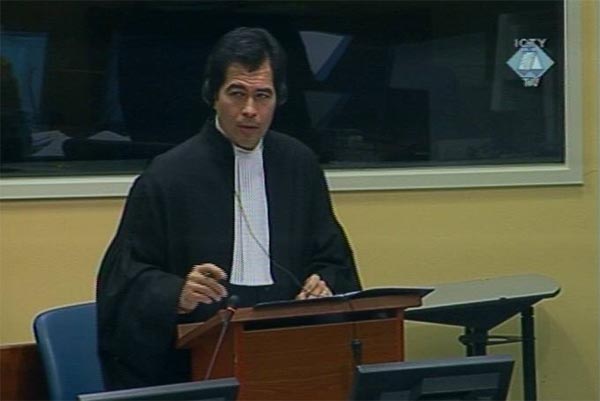Home
GOING AWAY "AS SOON AS POSSIBLE AS FAR AWAY AS POSSIBLE"
The prosecution starts presenting evidence on the unbearable living conditions in Zepa. The first to take the stand is a Bosniak from this enclave in Eastern Bosnia. He was captured as he tried to flee from the enclave in July 1995 and was then detained in Serbia for six months
 Norman Thayer, prosecutor in the trial of the former military and police officials charged with crimes in Srebrenica
Norman Thayer, prosecutor in the trial of the former military and police officials charged with crimes in Srebrenica The prosecution started presenting evidence about the crimes in the Zepa enclave in the summer of 1995 at the trial of seven Bosnian Serb military and police officers who are charged with the crimes. The first to take the stand was a protected witness testifying under pseudonym 155.
According to the indictment, the Republika Srpska Army (VRS) shelled Zepa on 10 and 11 July 1995. The purpose was to force the Muslim population to leave the enclave. This was dictated in the VRS Supreme Command Directive 7. What it orders is “to create conditions, through daily combat operations, conducted in accordance with the plan and design, of total insecurity, intolerability and hopelessness for further survival and life among the residents in the Srebrenica and Zepa areas". The prosecution claims it was drafted by the accused Radivoje Miletic, and signed by Radovan Karadzic, the then RS president.
Witness 155, a Bosniak from a village near Zepa, testified about the VRS attack and his escape from the enclave. Parts of his testimony were heard in private session. In parts of his evidence given in open session he confirmed that his 6-months year old son had been killed in a shelling on 11 July 1995.
The witness tried in vain to use the convoys bringing humanitarian aid to the enclave to move his family to Tuzla. Zepa and surrounding villages were shelled regularly, the enclave's water supply was cut off, and the population there lived in constant fear and under the pressure of people coming from Srebrenica in search of food.
Some 15 days after the fall of Srebrenica, while Zepa was still being shelled, the witness and his brother finally took their families to a place called Stitkov Do. There they had better chances to leave for Tuzla. The witness was very disturbed by the memories of the day he left his family "at the mercy of others" on 25 July 1995 and the court had to go into short recess.
The witness and his brothers joined the village guard. He then took shelter in a cave in the Drina canyon, the same cave "his father was hiding in from Chetniks during the Second World War". Soon, however, he accepted the advice of a fellow-fighter and schoolmate who suggested they should try to get to Macedonia via Serbia.
At the place called Crni Potok the witness crossed the Drina into the Serbian territory with a small group of Bosniak men. He was caught on 2 August 1995 after a short time he had spent in hiding. He was transferred to the Sljivovica camp. Two days later he was "transported to the Mitrovo polje camp with other 450 prisoners". He stayed there until 22 January 1996. In a document he had to fill in prior to his release he didn't specify his desired destination. As he was warned that he should not state that he would like to return to BH, he just stated he wanted to leave "as soon as possible as far away as possible". The witness and his family live in the USA now.
General Milan Gvero's defense put it to the witness that his escape to Macedonia through Serbia was a part of "a large-scale military operation run from Sarajevo". David Josse implied that the witness received his orders to leave for Serbia over the radio from Sarajevo. The witness rejected this claim as “total rubbish". "What instructions, this was the time when I wanted to kill myself", the witness said.
Linked Reports
- Case : Popovic et al. - "Srebrenica"
- 2007-02-02 INVESTIGATOR AND THE ACCUSED HAD AN EIGHT-HOUR LUNCH
- 2007-01-30 A DAY TO FORGET
- 2007-01-29 MILITARY POLICE "WAS ASHAMED BUT HELPLESS"
- 2007-02-06 WHAT HAPPENED TO AVDO PALIC?
- 2007-02-07 WITNESS WENT FROM SREBRENICA TO KRAVICA TO ZEPA AND SURVIVED
- 2007-02-09 PROVING INTERCEPTED CONVERSATIONS WERE AUTHENTIC
